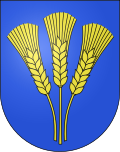Orges VD
| VD is the abbreviation for the canton of Vaud in Switzerland and is used to avoid confusion with other entries of the name Orges . |
| Orges | |
|---|---|
| State : |
|
| Canton : |
|
| District : | Jura north vaudois |
| BFS no. : | 5924 |
| Postal code : | 1430 |
| Coordinates : | 535120 / 184 422 |
| Height : | 560 m above sea level M. |
| Height range : | 484–617 m above sea level M. |
| Area : | 4.02 km² |
| Residents: | 333 (December 31, 2018) |
| Population density : | 83 inhabitants per km² |
| Website: | www.orges.ch |
|
Orges town center |
|
| Location of the municipality | |
Orges is a municipality in the Jura-Nord vaudois district in the canton of Vaud in Switzerland .
geography
Orges lies at 560 m above sea level. M. , 5 km northwest of the district capital Yverdon-les-Bains (air line). The clustered village extends on the gently sloping southern slope of the Miriau, at the foot of the Jura , in a panoramic position around 130 m above the lake level of Lake Neuchâtel .
The area of the 4.0 km² municipal area covers a section of the northern Vaud Central Plateau. The community soil extends from the Bois de Lily northwards over the slope of Orges to the height of Le Miriau , at 616 m above sea level. M. the highest point of the municipality is reached. To the west of this height is an extensive plateau at the foot of the Jura, which is bounded in the north by the valley of the Arnon and in the south by that of the Brine . In 1997, 7% of the municipal area was accounted for by settlements, 15% for forests and woodlands and 78% for agriculture.
The farm settlements of Montavaux ( 583 m above sea level ) and Longeville ( 600 m above sea level ) on the slope of the Miriau as well as some individual farms belong to Orges . The neighboring municipalities of Orges are Vuiteboeuf in the west , Vugelles-La Mothe in the north, Giez in the east, Valeyres-sous-Montagny in the south and Champvent in the south-southeast .
population
With 333 inhabitants (as of December 31, 2018), Orges is one of the small communities in the canton of Vaud. 92.1% of the residents are French-speaking, 3.5% Portuguese-speaking and 3.5% German-speaking (as of 2000). The population of Orges was 189 in 1900. After the population had decreased to 154 by 1970, an increase in population has been registered again since then.
economy
Orges was a predominantly agricultural village until the second half of the 20th century . Even today, the have farming and fruit growing an important role in the employment structure of the population. Further jobs are available in local small businesses and in the service sector. Orges has also developed into a residential community over the past few decades. Some workers are therefore commuters who work mainly in Yverdon .
traffic
The community is well developed in terms of traffic, although it is away from major thoroughfares. The main access is from Yverdon . The Yverdon-Ouest motorway junction on the A5 , which opened in 1984, is around 3 km from the town center. Orges is connected to the public transport network through the Postbus course, which runs from Yverdon to Novalles .
history
The place was first mentioned in a document in 1261 under the name Orses . The place name goes back to the dialect word ors from the Latin ursus (bear) used in the patois . Orges belonged to the La Mothe rule in the Middle Ages . With the conquest of Vaud by Bern in 1536, the village came under the administration of the Bailiwick of Yverdon . After the collapse of the Ancien Régime , Orges belonged to the canton of Léman from 1798 to 1803 during the Helvetic Republic, which then became part of the canton of Vaud when the mediation constitution came into force . In 1798 it was assigned to the Yverdon district. Until 1849, Orges was part of a large parish that also included La Mothe, Vugelles and Longeville.
Attractions
In Orges there are still some characteristic farmhouses from the 17th to 19th centuries. To the north of the village is the Longeville manor in a park.
Web links
- Community information
- Official website of the municipality of Orges
- Aerial views of the village and its surroundings
- Philippe Heubi: Orges. In: Historical Lexicon of Switzerland .
Individual evidence
- ↑ Permanent and non-permanent resident population by year, canton, district, municipality, population type and gender (permanent resident population). In: bfs. admin.ch . Federal Statistical Office (FSO), August 31, 2019, accessed on December 22, 2019 .









